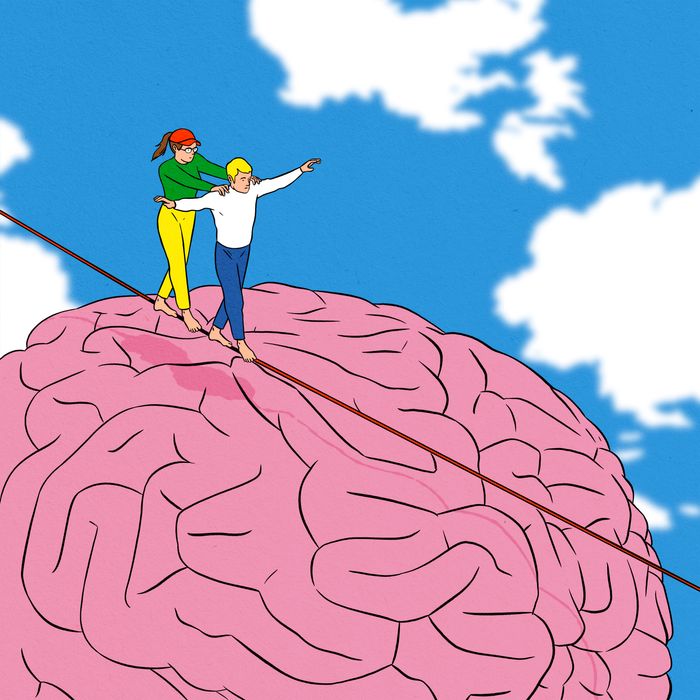
What is wrong with you?” is a rich and open question. When it comes from other people, it is “aggressive” or “rude,” but when you pose it to yourself, it is endlessly fascinating. What is wrong with you?
For better or for worse, a buffet of terminology has emerged that might help explain your terminal unease. Maybe you are struggling with boundaries or your social circle is overrun with toxic people. Maybe your mother or roommate or ex-boyfriend is a narcissist. Maybe you are traumatized, which is perhaps one reason you are also anxiously attached. The problem with these words, of course, is that their impact fades with use, leaving us to hunt for new language that can justify our suffering. By early 2024, we seem to have landed on our latest favorite diagnosis: Have you considered the possibility that you might be dysregulated?
The odds seemed high. In a podcast interview last summer, an author explained that while discovering nonmonogamy had been a revelation, actually enacting it had initially caused “utter panic and dysregulation.” In a blog post on how to conquer dating anxiety, the Gottman Institute advises you to “surround yourself with emotionally safe people,” which “helps to regulate one’s nervous system.” On anonymous forums, people worried whether their dysregulation was affecting their work performance — a concern their bosses seemed to share, which is perhaps why corporate-wellness blogs and workplace “thought leaders” have advised managers to pay attention to their employees’ dysregulation. (“Is Your Team Struggling?” warned one headline. “Their Dysregulation May Impact Your Performance.”) School administrators reported that kids were showing up at school more dysregulated than ever. Their teachers weren’t far behind. In its course description for a training about workplace conflict, a college of social work in Ohio crisply identified the source of the problem: “Surprise! It’s not your age cohort, or workload, or low pay — it’s dysregulation!”
Often, the term appeared attached to formal diagnoses, as a symptom of ADHD or BPD or PTSD or ASD or generalized anxiety, but just as frequently it floated freely, explaining why you were yelling at your husband because — by way of hypothetical example — you couldn’t find the garlic powder and also your computer wasn’t working. Sometimes, people seemed to refer to a process taking place within the nervous system. (“Being sleep deprived can really dysregulate our control over the autonomic system,” offered the neuroguru Andrew Huberman.) Other times, the thing being dysregulated was one’s behavior or emotions. You were experiencing an outsized reaction to something that didn’t seem to warrant it; your behavior did not match the situation; your emotions were too big and intense and long-lasting, which was making it difficult to function. It could explain why you were breaking out or eating too much or not eating at all, why you’re thrill-seeking or sleeping poorly or exhausted; or why you’re depressed or experiencing gastrointestinal distress. On one health podcast from January, a clinician-slash-trainer suggested dysregulation might be why, despite consistent exercise, she had, for years, struggled to gain muscle in her legs. It was a constant threat. “You can’t trust someone who purposely wants to dysregulate you,” advised a TikTok video, which has been viewed more than 100,000 times.
Until last year, I had only thought about one person as dysregulating me: my daughter, who is a baby. The concept had saturated parenting discourse, appearing in books and blogs and pastel slides on Instagram. The idea is that children’s meltdowns are not malicious or even conscious but instead a natural consequence of their developing brains. These, according to modern parenting experts like Dr. Becky, are episodes of dysregulation; the child has not yet learned to control their response to stress, and it is your job, as a parent, to help by modeling a Zen-like state yourself: a relaxed body, a slow heartbeat, a quiet mind. “A dysregulated adult,” the psychiatrist Bruce D. Perry said, in his 2021 book co-written with Oprah, “cannot regulate a dysregulated child.” In her new book, The 5 Principles of Parenting: Your Essential Guide to Raising Good Humans, developmental psychologist and guru Aliza Pressman lays out countless parental self-regulation strategies, including breathing, meditating, running your hands under cold water, and “playing with a pet.” On my neighborhood parental Facebook group, I learned about a $27 webinar that would teach me “how regulation and connection shape cooperation.” The pressure to be Zen could be daunting. “The phrase ‘a dysregulated parent can’t regulate a child,’” one parenting Instagram account argued, “is making parents dysregulated.”
Parenting Instagram is where I first encountered the concept, and sometime last summer, late in pregnancy, the algorithm cracked me, and then the Baader-Meinhof phenomenon did its thing. I couldn’t help but begin to narrate my own experience in regulatory terms (I am dysregulated, I thought, crying in the shower). I couldn’t decide if it made things better, but it was so flexible. In a sentence, “dysregulated,” could replace everything from “panicked” or “overstimulated” or “irrationally flipping out” or “being in acute crisis,” and transform those messy conditions into something isolatable and objective.
That, of course, is what therapyspeak has always done: It simplifies, it distances, it clarifies. But unlike “triggered” or “boundaries” or other classics of the genre, “dysregulation” felt dispassionately medical, gesturing at the base mechanics of one’s misery. Perhaps mental health is simply a matter of monitoring one’s inner circuitry — an idea that slotted neatly into the lives and vocabularies of those who have learned to track heartbeats and sleep cycles and ovulation cycles and blood glucose levels and blood oxygen. Most tantalizing was that the word seemed to suggest a solution: Maybe if you could just tweak some inner levers and recalibrate some dials, you could at last reveal your best and calmest self.
Feeling bad is timeless, and so is the notion that the reason for your agony is that something in your bodily system is out of whack. Kathryn Tabb, a philosopher of science at Bard focused on psychiatric history, traces this pattern of diagnosis at least to Hippocrates, who believed that one’s health depended on the proper balance of the four humors. In his view, all problems stemmed from the proportions of those humors: Maybe a person had too much or too little blood or phlegm or bile, which was either too strong or too weak or improperly mixed. Then scientists discovered germs, which undermined the humors theory, but its underlying framework would prove infinitely adaptable.
In the 1990s, the logic of the humors found its place in the human brain. At the top of the decade, George H.W. Bush signed a presidential proclamation announcing that it was now the Decade of the Brain. New neuroimaging technology was converting neural activity into pictures, which were appearing everywhere from Newsweek to murder trials. A flood of research was giving us access to our own mental processes, and it looked like maybe we were going to solve philosophy, and perhaps finally understand ourselves. Neuroscience, Tom Wolfe wrote in 1996, was “on the threshold of a unified theory that will have an impact as powerful as that of Darwinism a hundred years ago.” (He wasn’t happy about it.) Prozac had just hit the U.S. market — followed by Zoloft, and then Paxil — and this new class of relatively gentle psychiatric drugs fundamentally changed how millions of Americans thought about their brains. “That’s probably when the idea really caught on that our emotional states have a neurobiological basis,” says Sally Satel, a psychiatrist and the co-author of Brainwashed: The Seductive Appeal of Mindless Neuroscience.
By then, scientists already understood that psychic stress — whether from war or avalanches or being late to work — caused dramatic changes in the nervous and endocrine systems, which manifested in physiological symptoms. But in the ’90s, a generation of researchers began proposing accounts of how stress not only worked upon the body but also lingered in it, creating a disequilibrium. In 1994, Robert Sapolsky, then an associate professor of biological sciences and neuroscience at Stanford, published Why Zebras Don’t Get Ulcers, explaining, in enthusiastic detail, the different ways that mammalian stress responses — the rush of adrenaline, shallow breath, and fast heart rate that were usually fantastic in acute physical emergencies like getting chased by a wolf — could start to wear down our various bodily systems in the face of modern, chronic stress (a passive-aggressive boss, the MTA). Bessel van der Kolk, then a psychiatrist at Harvard, published the first iteration of what would go on to become his best-selling manifesto, The Body Keeps the Score, which argued that trauma gets stored in the nervous system and physiologically altered how your body processes stressful events. Biophysicist Peter Levine, who wrote a popular self-help book on overcoming trauma, put forth a related theory: It wasn’t the trauma itself that caused long-lasting symptoms, but a “frozen residue of energy that has not been resolved and discharged; this residue remains trapped in the nervous system where it can wreak havoc on our bodies and spirits.”
What emerged was a popular understanding that extreme or chronic stress presented a regulatory problem, specifically in the autonomic nervous system. Two of the system’s components are the sympathetic nervous system and the parasympathetic nervous system. The first responds to danger or excitement by signaling the adrenal glands to release hormones like adrenaline and cortisol (also known as our fight-or-flight response), while the second promotes relaxation and recovery and basic bodily functions (“rest and digest”). One goes up, the other goes down, and vice versa. “Nervous system dysregulation” is what happens when the two are out of sync, and you stay stuck, either overactivated, or not activated enough. It wasn’t just the stress researchers and the traumatologists who were thinking about regulation. The neuropsychologist Russell Barkley had begun to argue that ADHD was not, in fact, just about deficient attention, but also deficient emotional self-regulation. Marsha Linehan, a former psychologist at the University of Washington, developed dialectical behavior therapy, or DBT, specifically to treat emotional dysregulation, which she argued was at the heart of borderline personality disorder. “She really shifted the way we look at personality disorders,” said Lina Perl, a clinical psychologist in New York who was first introduced to the word in graduate school. BPD wasn’t a fatal flaw intrinsic to your defective personality, but a regulatory issue, likely stemming from unmet childhood needs.
The dozen or so therapists, clinicians, and historians I spoke to couldn’t precisely pinpoint how or when “dysregulation” crossed over from the clinic into popular imagination, but they had theories. One obvious explanation is simply that as therapy and psychiatric diagnoses grew more mainstream, “dysregulation” rode its coattails. Several pointed to evolving understandings of various conditions. “To me, a smoking gun is the obsession with ADHD,” says Tabb, citing the recent explosion of newly diagnosed adults. Justin Baeder, an educational consultant and former school principal popular on TikTok, told me in the last year or so, he’d seen dysregulation morph. Once, it had been used in “a narrow technical sense,” generally describing students with disabilities, he told me. Now, “I’m hearing it used much more broadly to mean any kind of feelings — anytime a child is upset, they’re dysregulated.” It is, he suggests, a way to “medically explain away any type of bad behavior” (well-intentioned, but in his view, not especially productive).
Wellness culture predated the pandemic, but after years of inward focus, it got turbocharged. People had a lot of time to think, mostly about their health, and read, mostly about their trauma, and consume content on the internet, mostly about how to feel less bad. Regulation was an answer that seemed to cross demographic lines. Holistic influencers in bikinis were regulating (“three ways to soothe your nervous system”), but so were hyper-rational science bros. On his podcast, Huberman, in his trademark black button-down, offered all kinds of regulatory guidance for the chronic maximizer crowd. Jordan Peterson, wellness influencer for aggrieved men, extolled the virtues of emotional regulation. The proposed solutions were generally obvious — get sunlight, go to bed, meditate, eat breakfast.
It is true that neuroimaging shows brain activity and that stress is brain activity, and in that sense, sure, it would show up on a scan. If you found yourself, one day, in a state of what you called “dysregulation,” and at that moment you had an fMRI, it would show arousal centers activated in the brain, which you could see represented as bright glowing splotches. And if you had repeated scans, in different mental states, you would be able to see changes in the pattern or intensity of that activation. What the glowing splotches would not tell you is exactly what any of it means. Is dysregulation real? Of course it’s “real,” in the sense that yes, your experiences are mirrored in your brain, and yes, you can, at any given time, see activity that is different from other possible activity. But what are you supposed to do with that? “The line between the normal and the pathological is something we construct,” says Tabb. There’s a lot we still don’t know about the way our nervous system works in relationship with the rest of our body. “It’s as if we were outside the restaurant pressing our faces against the restaurant window looking in without being able to access what’s going inside the restaurant at all,” the medical historian Edward Shorter told me.
In some ways, “dysregulation” is an updated version of another science-coded phrase we used to like: “chemical imbalance.” Picture the Zoloft commercial from the early aughts that featured line drawings of “nerve A” and “nerve B” on a plain-white background. “Depression may be related to an imbalance of natural chemicals between nerve cells in the brain,” chirped the voiceover, as dots floated erratically between the two illustrated nerves. “I think it’s such a tantalizing metaphor because it’s so straightforward,” says Nate Greenslit, an anthropologist of science. “If you can think of it as a soupy mixture of different chemicals, and if those chemicals are out of balance with each other, then you will suffer as a consequence.” The only problem with Zoloft’s early diagram is that it isn’t true. A major 2022 umbrella review showed what had been an open secret in the field: There is no substantial evidence that low serotonin causes depression. A lot of people do do well on SSRIs, but we don’t know why. “There is no ‘chemical imbalance,’” University of Virginia sociologist Joseph E. Davis told me, bluntly. “That was a misnomer right from the start.” More recent commercials make no claims about root causes. These days, they tend to feature generic women doing normal things looking ambiently bummed.
Dysregulation doesn’t yet carry the same baggage. Functionally, it’s similar, in that it locates your problem in your biology rather than your personality, which is comforting. But unlike being “chemically imbalanced,” which sounds like an intractable, if treatable, feature of a person, being “dysregulated” sounds like a reassuringly temporary state. “It strikes me as more dynamic, less static, than the language of chemical imbalance,” agrees Greenslit. “Chemical imbalance is also very, very individualistic: You as an individual have programmatic biology, and so the solution is at an individual level.” Dysregulation, on the other hand, “implies relationships.” You’d be chemically imbalanced anywhere, but you couldn’t be dysregulated in a vacuum. “It doesn’t say there’s something inherently wrong with you,” the founding director of Health Justice Commons and senior adjunct lecturer at the California Institute of Integral Studies Mordecai Cohen Ettinger, told me. “It’s saying your body has been harmed, or decentered, or stressed from a set of traumatic events, so you are dysregulated, and that is just a normal biological consequence of what you’ve experienced.” In this sense, it is the best possible therapyspeak for this moment, when the climate is in crisis and there are microplastics in the water as well as a widespread hopelessness and a grim election looming and a pervasive sense of tenuousness, interpersonally and economically, and it is tiresome to list these things, I know, but isn’t it also true?
The fundamental appeal of regulatory language is the idea that there is a calm stasis to return to, a “you” separate from your acute distress. “I think from what I’ve heard from my clients, it most often refers to the sensation that they don’t feel like themselves,” said Lisa Daronatsy Kiyindou, a health and fitness trainer in New York. “They’re trying to get back to feeling more like themselves.” There is a kind of longing in dysregulation. People were struggling not to change, but to recapture an idea of who they’d been before. You may be a wreck on a hair trigger now, but that isn’t at the core of who you are. I am dysregulating, I thought, and was struck by the perverse optimism of it. I was a mess, but there was hope.




